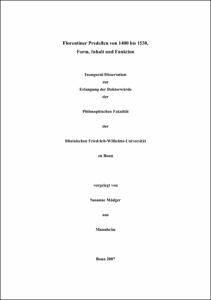Florentiner Predellen von 1400 bis 1530Form, Inhalt und Funktion

Florentiner Predellen von 1400 bis 1530
Form, Inhalt und Funktion

| dc.contributor.advisor | Satzinger, Georg | |
| dc.contributor.author | Mädger, Susanne | |
| dc.date.accessioned | 2020-04-09T09:31:29Z | |
| dc.date.available | 2020-04-09T09:31:29Z | |
| dc.date.issued | 2007 | |
| dc.identifier.uri | https://hdl.handle.net/20.500.11811/2750 | |
| dc.description.abstract | Predellenbilder des Quattrocento erfreuten sich bei Kennern und Sammlern großer Beliebtheit, weil auf ihnen besonders vielseitig, innovativ und realitätsnah erzählt wurde. Nur selten sind diese Bilderzählungen, die das Sockelgeschoß von Retabeln zierten, im Altarzusammenhang erhalten. Die besonderen Inhalte und Aufgaben sowie die spezifische Funktion der Predella in ihrem ursprünglichen Kontext zu analysieren, ist das Ziel der vorliegenden Untersuchung. Zugrunde liegt ein repräsentatives Corpus von 128 Retabeln, die zwischen 1400 und 1530 von Florentiner Malern geschaffen wurden, darunter Fra Angelico, Filippo Lippi, Benozzo Gozzoli, Ghirlandaio, Botticelli und Raffael. Die in allen Teilen überlieferten oder zumindest sicher rekonstruierten Retabel des Corpus sind in einem datenbankbasierten Katalog dokumentiert. Dessen statistische Auswertung bildet die Grundlage der Analysen. Ein Schwerpunkt der Untersuchung liegt auf dem Themenspektrum und der Erzählweise der Predellenmalerei, ein zweiter gilt dem Spannungsfeld der mit Predellenerzählungen verbundenen Interessen von Auftraggebern und Orden. Die repräsentative Materialbasis läßt dabei erstmals allgemeine Aussagen über die inhaltliche und gesellschaftliche Funktion der Predellenmalerei zu. Innerhalb des Altaraufbaus ist die Predella der Ort der Bilderzählung. Ihre Hauptakteure sind die Schlüsselfiguren der Gnadenmittlerschaft, d. h. die Gottesmutter und Heilige. Tritt Christus selbst auf, so meist nur in der Predellenmitte in der Bildformel des Schmerzensmannes als überzeitliche Repräsentation der Eucharistie. Aus dem Vergleich der Szenenauswahl und Erzählweise mit den Textquellen einerseits und den Darstellungen auf Retabel-Haupttafeln und Fresken andererseits konnte der spezifische Exempelcharakter der Predellenerzählungen abgeleitet werden. Sie sollten die Fürsprachekraft der angerufenen Heiligen beweisen und als Gebetsanleitung dienen. Ausführlich wird dargestellt, wie sie zwischen der hieratischen, Distanz schaffenden Sphäre der Haupttafel und der Welt des Betrachters vermittelten. Doch ging es dabei keineswegs ausschließlich um das Seelenheil. Vielmehr wurden die Erzählungen auf Predellen von ihren Auftraggebern und den Orden, in deren Kirchen die Retabel aufgestellt waren, auch anderweitig instrumentalisiert. Mit welchen Aussagen sich die einzelnen Orden, überwiegend Bettelorden, an ihre Zielgruppen wandten, und welche Formen der Selbstdarstellung private Auftraggeber, Bruderschaften und Zünfte wählten, wird anhand ausgewählter Retabelgruppen analysiert. | en |
| dc.description.abstract | Florentine Predelle from 1400 to 1530 - Form, Content and Function Quattrocento predella panels were very popular amongst connoisseurs and collectors because of their varied, innovative and realistic narrative character. Formerly decorating the bases of retables, these narrative scenes have seldom survived as part of the original altarpiece ensemble. The present study analyses the special content of the predella in its original context, as well as its specific function. The research is based on an exemplary corpus of 128 retables painted between 1400 and 1530 by Florentine artists, amongst them Fra Angelico, Filippo Lippi, Benozzo Gozzoli, Ghirlandaio, Botticelli and Raphael. The altarpieces that have been handed down intact or reconstructed with certainty are documented in a catalogue based on database records. The statistical evaluation of this catalogue constitutes the basis of the analyses. One main area of the study focuses on the thematic spectrum and narrative form of predella painting, a second area considers the impact of patrons’ and religious orders’ conflicting interests on predella narratives. The representative basis of the investigated material allows, for the first time, general conclusions to be drawn on the contents and social function of this kind of painting. The predella is the area allocated for pictorial narrative within the altarpiece structure. Its main characters are the key figures of intercession: the saints and the Virgin. If Christ himself was represented, then almost always on the centre panel of the predella as the Man of Sorrows, in the pictorial type depicting the time-transcending representation of the Eucharist. The specifically exemplary character of the predella narratives can be derived by comparing, on the one hand, the selection of the scenes and narrative style with the text sources, and, on the other, with the depictions on the main panels of retables and frescoes. They were supposed to prove the intercessory power of the saints and also serve as instructions for devotion. The study examines in detail how the predella mediated between the remoteness of the hieratical sphere evoked by the main panel and the world of the beholder. But salvation of the soul was not their only concern. Rather, patrons and religious orders who had the altarpieces set up in their churches also applied these narratives in other ways. What the different, mostly mendicant orders sought to articulate and mediate to their audience and what forms of self-presentation were chosen by private patrons, brotherhoods and guilds has been analysed using selected retable groupings. | en |
| dc.language.iso | deu | |
| dc.rights | In Copyright | |
| dc.rights.uri | http://rightsstatements.org/vocab/InC/1.0/ | |
| dc.subject | Predella | |
| dc.subject | Retabel | |
| dc.subject | Malerei | |
| dc.subject | Renaissance | |
| dc.subject | Florenz | |
| dc.subject | Bildzyklus | |
| dc.subject | Hagiographie | |
| dc.subject | Bettelorden | |
| dc.subject | Bruderschaft | |
| dc.subject | Zunft | |
| dc.subject.ddc | 750 Malerei | |
| dc.title | Florentiner Predellen von 1400 bis 1530 | |
| dc.title.alternative | Form, Inhalt und Funktion | |
| dc.type | Dissertation oder Habilitation | |
| dc.publisher.name | Universitäts- und Landesbibliothek Bonn | |
| dc.publisher.location | Bonn | |
| dc.rights.accessRights | openAccess | |
| dc.identifier.urn | https://nbn-resolving.org/urn:nbn:de:hbz:5-10385 | |
| ulbbn.pubtype | Erstveröffentlichung | |
| ulbbnediss.affiliation.name | Rheinische Friedrich-Wilhelms-Universität Bonn | |
| ulbbnediss.affiliation.location | Bonn | |
| ulbbnediss.thesis.level | Dissertation | |
| ulbbnediss.dissID | 1038 | |
| ulbbnediss.date.accepted | 04.02.2004 | |
| ulbbnediss.fakultaet | Philosophische Fakultät | |
| dc.contributor.coReferee | Raupp, Hans-Joachim |
Dateien zu dieser Ressource
Das Dokument erscheint in:
-
E-Dissertationen (698)





